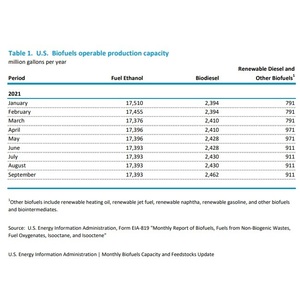EIA: US biofuel capacity up in September, feedstock use down

November 30, 2021
BY Erin Voegele
Operable biofuels production capacity in the U.S. expanded by 32 MMgy in September to 20.766 billion gallons per year, according to data released by the U.S. Energy Information Administration on Nov. 30. Feedstock consumption was down for the month.
The increase in operable biofuels capacity came from expanded biodiesel production capacity. Capacity levels for fuel ethanol and other biofuels, defined as renewable heat oil, renewable jet fuel, renewable naphtha, renewable gasoline and other biofuels and biointermediates, remained steady.
Fuel ethanol capacity was at 17.393 billion gallons per year in September, a figure that has held steady since April. Biodiesel capacity expanded to 2.462 billion gallons per year, up from 2.43 billion gallons reported the previous month. Capacity for other biofuels was at 911 MMgy, flat with the previous three months.
Advertisement
Advertisement
A total of 24.308 billion pounds of feedstock went to biofuels production in September, down from an estimated 24.948 billion pounds in August.
Biofuel producers consumed approximately 22.799 billion pounds of corn in September, down from 23.196 billion pounds the previous month. Grain sorghum consumption was also down, falling to 27 million pounds, compared to 30 million pounds consumed in August.
The EIA reported that 756 million pounds of soybean oil was used to produce biofuels in September, down from 815 million pounds in August. Corn oil and canola oil consumption also fell. Biofuel producers consumed 167 million pounds of corn oil and 106 million pounds of canola oil in September, down from 199 million pounds and 142 million pounds, respectively, in August.
Advertisement
Advertisement
The consumption of waste oils, fats and greases was also down in September. Biofuel producers consumed 18 million pounds of poultry fat during the month, flat with August. Tallow consumption fell to 90 million pounds, down from 120 million pounds. The consumption of white grease was at 54 million pounds, down slightly from 55 million pounds in August. Biofuel producers consumed only 219 million pounds of yellow grease in September, down from 305 million pounds the previous month. Waste oils, fats and greases classified as “other” fell to 5 million pounds, down from 8 million pounds.
Biofuel producers also consumed 63 million pounds of feedstock classified as other recycled feeds and wastes, up from 60 million pounds in August. The consumption of other biofuel feedstocks not elsewhere specified or identified (NESOI) in the EIA’s report was at 4 million tons in September. Data on NESOI feedstock was not reported for August to avoid disclosure of individual company data.
Full copies of the EIA’s monthly biofuels capacity and feedstock reports is available on the agency’s website.
Related Stories
The USDA on April 14 announced the cancellation of its Partnerships for Climate-Smart Commodities program. Select projects that meet certain requirements may continue under a new Advancing Markets for Producers initiative.
The Michigan Advanced Biofuels Coalition and Green Marine are partnering to accelerating adoption of sustainable biofuels to improve air quality and reduce GHG emissions in Michigan and across the Great Lakes and St. Lawrence Seaway.
The USDA reduced its outlook for 2024-’25 soybean oil use in biofuel production in its latest World Agricultural Supply and Demand Estimates report, released April 10. The outlook for soybean oil pricing was revised up.
EIA reduces production forecasts for biobased diesel, increases forecast for other fuels, including SAF
The U.S. Energy Information Administration reduced its 2025 forecasts for renewable diesel and biodiesel in its latest Short-Term Energy Outlook, released April 10. The outlook for “other biofuel” production, which includes SAF, was raised.
FutureFuel Corp. on March 26 announced the restart of its 59 MMgy biodiesel plant in Batesville, Arkansas. The company’s annual report, released April 4, indicates biodiesel production was down 24% last year when compared to 2023.
Upcoming Events










